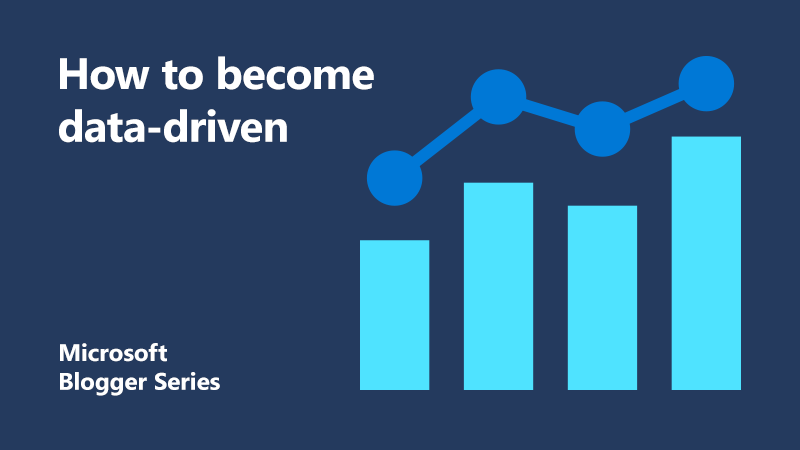
How to become data-driven: 6 steps to success
At the beginning of a new decade, there’s a lot to reflect on in terms of digital transformation. It’s amazing the changes we’ve seen across different industries, ways of working, and the competitive landscape. Data-driven insights are key to these opportunities.
The opportunities created by digital transformation not only affect how businesses run but they also affect our lives as consumers. It doesn’t seem that long ago that on a Friday night, I’d head down to the local Blockbusters store to pick out a new film whereas now I don’t need to leave the comfort of my own home!
However, as organisations adapt to become more data-driven, there’s lots of challenges they must address on their journey. A recent Harvard Business Review’s report looked into why some analytic strategies fall short but others succeed. I’ll be delving into a few highlights from this report, as well as discussing where we’re seeing customer success with delivering insights at scale.
1. Get the basics right
Global consumer goods company Reckitt Benckiser who produces health, hygiene, and home products is one of many companies who are using technology to unlock the power of data and empower their employees to work smarter. Executives at Reckitt Benckiser are now seeing a direct link between business performance and decisions based on high-quality data.
Whilst the majority of business leaders agree that effective data and analytics strategies are essential for business transformation, success in this area is hard to achieve and organisations are struggling to become mature users of data and analytics.
If you’re expecting a quick journey to becoming data-driven, you’re likely to fail. You need to get the basics right. This is a process that must be continually modified based on changes in your markets, your business, and in technology.
2. Unlock your data
Data silos and difficulties managing data from multiple new systems is often stated as the root cause of disappointing results. This is because siloed data locks information within individual departments and can block insights being generated by the wider organisation.
To enable a broader dissemination of information, these data siloes need to be eliminated. Organisations that leverage technologies like data warehouses to bring together data from different formats, sources, and applications can derive insights that are richer than from a single source.
Whilst going through their transformation, Reckitt Benckiser realised they needed to become more data-driven and unlock more than just their internal operational data. To get a holistic view of their business, they also needed third-party data from retailers and their competitors to understand their performance. More importantly, they needed it all to know what to do next.
To do this, they built a modern data warehouse solution to bring together a variety of data from different sources in Azure HDInsight and Azure SQL Data Warehouse (now Azure Synapse Analytics). They used Power BI to make the data easily accessible in one view across the organisation.

3. Manage your data
The success for analytics really depends on the quality of your data. Data inaccuracies can be created in one department and then easily spread throughout an entire organisation.
Therefore, it’s important to invest in an effective framework for reliable data management which can address a range of tasks. This includes creating rules for sharing information across departments and monitoring the accuracy of new records to enable better data governance.
NEL support over 43 London clinical groups. They had a vision to improve their ability to predict health outcomes by using advanced analytics. To achieve this, they first had to create a system to better integrate and govern their data. Once they put this data management system in place, they enabled their customers to deliver personalised care and improve patient outcomes by making more accurate healthcare predictions.
“We’re giving the clinicians the intelligence to have an informed conversation that helps patients learn about their risk factors,” says Graham Crawford, NEL’s director of analytics.
4. Turn insights into action
By investing in data management solutions, organisations put themselves into a better position to take advantage of advanced analytics. Technologies, such as machine learning and AI, support their decision making and turn insights into action.
UK insurer LV= needed a different way of doing business to support customers whose car accidents fall into the grey area of who’s at fault. Working with their data scientists and Microsoft Services, they implemented an Azure machine learning solution that reduced these grey area outcomes from 20 percent to 3.9 percent. As a result, they had better claim resolution outcomes and delivered better customer experiences.
5. Build employees skills
Even if you invest in the latest analytics tools, to truly become a data-driven organisation you need to ensure your employees know how to utilise them. In order to take the best advantage of new technology, you need to invest in developing your employees. Help them gain new skills and adapt to the cultural change within your organisation.
As Bk Vasan, Executive Director of Data Engineering, Cloud and Advanced Analytics at T-Mobile correctly said: “the biggest opportunities with analytics come from enabling people to think differently based on the insights they’re getting from data.”
At Microsoft, we have heavily invested into skills for both out internal employees and our customers that you can take advantage of today. Find learning paths for Azure Data Engineers plus many more on Microsoft Learn here.
6. Gain a competitive advantage
It’s very clear that analytics adds a competitive differentiator in most industries, but Rome wasn’t built in a day. The key to getting started is to get the basics right and then ‘land and expand’.
Identify two or three business goals, understand what data is needed to support these and then demonstrate quick wins that validate your analytics strategies. The actions generated from these insights are what then enables you to re-imagine how you engage with your customers, transform your products, optimise your operations, and enable your employees.
I look forward to seeing what’s next in 2030…
Find out more about becoming data-driven
Discover what makes a successful analytics strategy
How to use analytics in the cloud
About the author 
Jodie is Microsoft UK’s Cloud Scale Analytics and IoT Lead. She is passionate about the opportunities that technology creates through digital transformation, with data and analytics strategies playing a key role. Starting her career with a Computer Science BSc Honours, Jodie has worked in a wide range of industries from Space and Defence to Financial Services before joining Microsoft in 2017 as a Partner Technology Strategist for MSPs.




